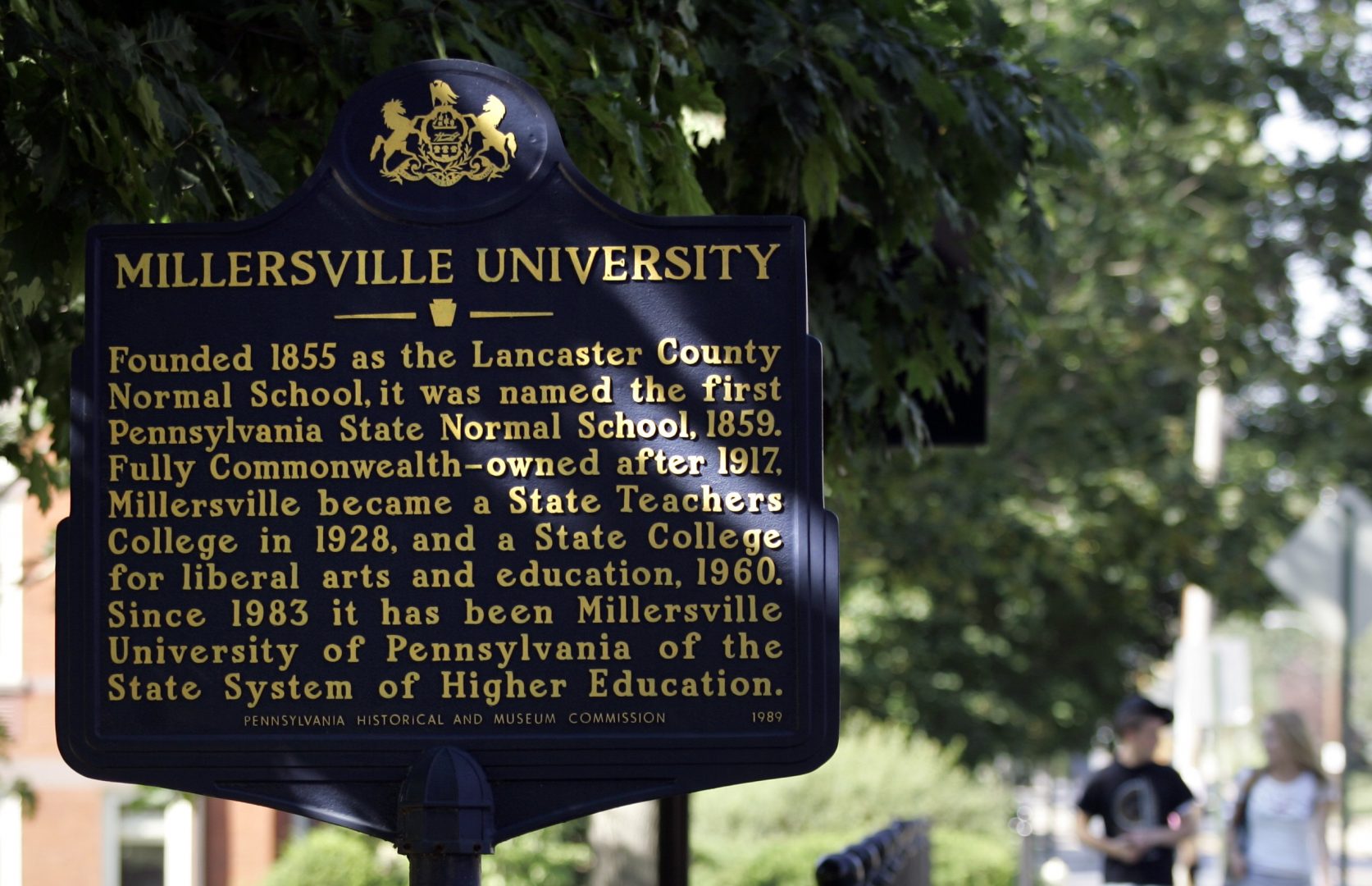
FILE PHOTO: A Millersville University sign is seen on campus in Millersville.
Carolyn Kaster / The Associated Press

FILE PHOTO: A Millersville University sign is seen on campus in Millersville.
Carolyn Kaster / The Associated Press

Carolyn Kaster / The Associated Press
FILE PHOTO: A Millersville University sign is seen on campus in Millersville.
(Harrisburg) — The day is coming when students enrolling in one of the state’s 14 public universities will be able to take any one of the more than 11,000 courses offered at any of the universities in the State System of Higher Education.
And that day is not too far off.
The system’s board on Wednesday adopted a framework for reinventing itself to operate on a multi-university regional or statewide basis while preserving each of the 14 universities. It also affirmed a plan for next steps to begin to put its transformation into action on an aggressive time schedule especially for higher education where change generally comes at a slow pace.
“We’re on our way. We’re out of the starting box,” said system board Chairwoman Cynthia Shapira after all board members in attendance cast an affirmative vote to accept the framework and related actions.
While the system’s redesign plan is complex and requires a willingness to change, system officials see it as not only a way to make the system sustainable to serve the commonwealth and its workforce needs going forward but also a way to expand opportunities for students.
These changes come not by choice but by necessity.
The financial health of its universities are declining as they struggle with competition for a shrinking pool of high school graduates, rising tuition that is driving away low- and middle-income class families, and state funding that hasn’t kept up with its rising costs.
In his State of the System Address delivered prior to the board meeting following his installation, Chancellor Dan Greenstein said this deterioration within in the system occurred over years, maybe decades.
“We are here today because at every level of our organization, we’ve not been able to align around a shared vision and to pursue it together,” he said.

Michael Rubinkam / The Associated Press
In this Jan. 25, 2018, photo, books on display at the Indiana University of Pennsylvania library in Indiana, Pa..
But that resistance to being what he called a “sharing system” or “systemness” stops with this board-accepted vision he crafted.
It grew out of a system self-study exercise that began before his arrival in 2016 but took flight from the moment he stepped into his job in September. He went on a systemwide tour listening to students, faculty, staff, business and community leaders and elected officials about what the system meant to them and how its could be challenges could be addressed.
While the redesign is complex, perhaps the most visible change that students and their families will see is the value added to a system education by opening up courses across campuses without morphing into one big university, Shapira said. She sees this as better positioning the system universities to compete with Penn State, Pitt and Temple.
“In my mind, it’s not taking away from the identity of any university but it’s adding by saying the students, the faculty, all of our stakeholders will know that behind that individual university that you love and you are going to, you have the backup of the system,” she said.
This move to open up all campuses’ course offerings to all students could happen as soon as two years from now – and that prospect has students excited, said board member Rodney Kaplan Jr., a student at West Chester University.
“I’m optimistic,” he said.
Greenstein, a former Gates Foundation postsecondary success strategy director, said the challenges the system faces are not unlike those that other public higher education institutions in this country are facing except they are “concentrated in super high doses here in Pennsylvania.” He is hoping his plan to overcome those challenges could serve as a national model of what 21st century higher education looks like.
His enthusiasm, energy, knowledge of higher education, and aspirational tone struck a chord with many in the audience of 120 who listened to his address.
HACC President John”Ski” Sygielski said he was impressed by Greenstein’s research-based approach to put together a plan for the system and is delighted that working more with community colleges fits into it.
“We’re looking forward to working with him because he understands where higher education is today and how it has to be transformed to meet the needs of the changing economy that we’re all existing and working in in Pennsylvania,” Sygielski said.
Tom Foley, president of the statewide association of independent and private colleges, said what Greenstein had to say in his 21-minute speech was a lot to digest but he sensed the new chancellor wants the best for students, higher education, and the commonwealth.
“So anything Dan is able to accomplish to improve that system and make it more responsive, we’re all in favor of,” Foley said.
Former system board chairman and Kutztown University trustee Guido Pichini sounded at least a tad nervous about the changes that the Greenstein era will introduce into the 36-year-old system.
“I hear a lot of what he’s saying. Hopefully we’re going in the right direction,” he said.
In faculty union president Ken Mash’s eyes, the chancellor is off to a good start. He is including the faculty in his discussions about moving the system forward and shown he has a collaborative style, grasp of the issues, willingness to listen and alter his views, and take criticism. He said Greenstein will appear for a second time before a gathering in February of union leaders from across the system to defend his redesign plan and listen to concerns about it.
“That’s a sign of a good leader,” Mash said.
The State System educates nearly 100,000 students and includes Bloomsburg, California, Cheyney, Clarion, East Stroudsburg, Edinboro, Indiana, Kutztown, Lock Haven, Mansfield, Millersville, Shippensburg, Slippery Rock and West Chester universities.

Get insights into WITF’s newsroom and an invitation to join in the pursuit of trustworthy journalism.
The days of journalism’s one-way street of simply producing stories for the public have long been over. Now, it’s time to find better ways to interact with you and ensure we meet your high standards of what a credible media organization should be.